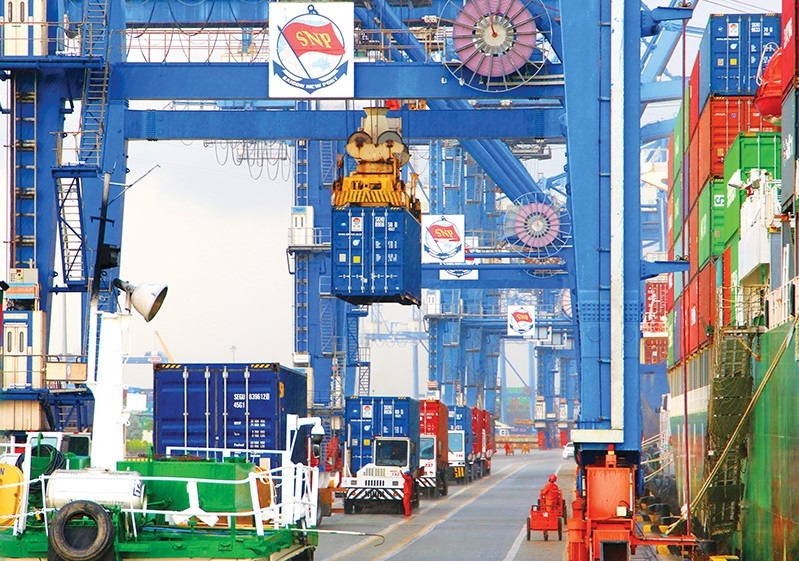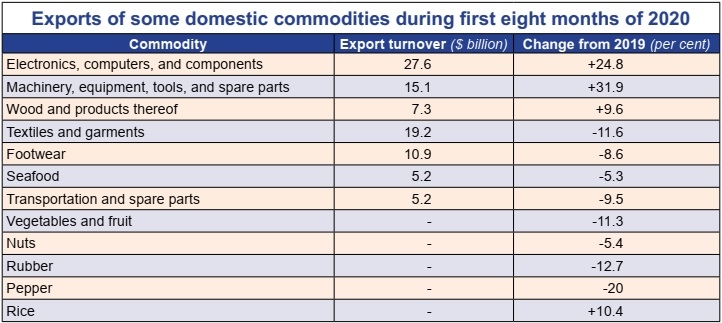Setting course for a healthy trade balance
 |
| Dr. Vu Dinh Anh, expert from the Ministry of Finance’s Price Market Research Institute |
During the first eight months of the year, Vietnam’s trade surplus reached a record high of $11.9 billion, despite the heavy impact of the pandemic. With such results, the country scored three times as much as in 2019 ($3.4 billion) and 2018 ($4.9 billion).
Vietnam’s significant trade balance of commodities is influenced by four main factors.
Firstly, although international trade has been dampened by the ongoing health crisis, the nation’s export turnover reached $174.1 billion, up 1.6 per cent on-year. Meanwhile, imports of goods amounted to $162.21 billion, down 2.2 per cent over the same period last year.
In other words, the main reasons for the country’s outstanding trade surplus are the decline of imports, not the rise in exports. Compared to 2019 and 2018, the national export turnover only rose marginally as both previous years saw a rise of 8.8 and 7.3 per cent, respectively.
Secondly, like the development in previous years, in the first eight months of 2020, domestic enterprises suffered from a trade deficit of $11.2 billion while foreign-invested enterprises (FIEs) maintained a surplus of $23.1 billion. However, the local enterprises’ deficit decreased dramatically from $18.4 billion in the same period of 2019, while the FIEs’ surplus only increased slightly, from $21.8 billion in the first eight months of last year.
Thus, the main contributor to Vietnam’s trade surplus during this timeframe is currently the domestic sector. The large reduction in the domestic trade deficit is due to export turnover reaching $60.8 billion in the first eight months of 2020, an increase of 15.3 per cent compared to last year. Meanwhile, imports stood at $72.05 billion at the end of August, representing a small increase of 2.9 per cent. This significant difference meant that the domestic sector could achieve a record export surplus for the whole economy.
 |
| Vietnam currently boasts a positive trade surplus, despite the complexities that 2020 has brought, photo Le Toan |
 |
Import reductions
This excellent performance seems even more impressive when compared to FIEs’ performance in the first eight months of this year, which only exported goods worth around $113.31 billion (including crude oil), representing a decrease of 4.5 per cent compared to the corresponding period in the previous year.
FIEs’ exports are much more sensitive to the impact of the global health crisis. Last year, their exports still increased by 4.6 per cent compared to 2018 when the increase amounted to 13.4 per cent compared to 2017. Nevertheless, as their imports also dropped 6 per cent on-year, Vietnam’s trade surplus from FIEs could still be maintained at over $20 billion.
Thirdly, the export and import turnover of FIEs decreased as most of its stronger commodities did so. For instance, phones and components only reached $31.5 billion, accounting for 18.1 per cent of Vietnam’s total export turnover, down 5.5 per cent on-year. Meanwhile, the import of phones and components hit $8.8 billion, down 2.5 per cent on-year. On the contrary, strong export commodities of domestic businesses had mixed movements (see table).
With the exception of electronics, computer, and component imports – with import turnover of $38.6 billion, up 15.2 per cent over the same period in 2019 – the majority of imports were reduced during the first eight months of the year. For example, imports of plastics decreased by 12.3 per cent, cars went down 28 per cent, and chemical imports fell by 8 per cent.
Lastly, the record export surplus originates mainly from the strong increase in exports to Vietnam’s major trade partners. As such, exports to the US were $46.7 billion, up 19 per cent compared to the first eight months of 2019, and exports to China amounted to $27 billion, up 13 per cent.
| In August, Vietnam’s export turnover reached $26.5 billion, an increase of 6.5 per cent compared to July, mainly due to Samsung efforts to export its newest mobile phone model, the Note 20. Export turnover of Samsung Vietnam in the first six months slightly decreased compared to the same period last year, when the company hit $28 billion. Samsung mainly focuses on mobile devices, consumer electronics, and electronic components like displays and batteries. In the early days of the pandemic, Samsung met some difficulties with raw materials for its production, but thanks to the rapid interventions of the Vietnamese government, production is currently stable. Similar to other enterprises in the electronics industry, Samsung also has been affected by the decrease in global demand but tries to remain on track with its export goals. |
Domestic victories
Meanwhile, the export turnovers for the EU, ASEAN, and Japan reached $22.9, $15, and $12.5 billion, down 4, 13.6, and 6.1 per cent on-year, respectively.
Meanwhile, imports from the EU amounted to $9.5 billion (up 4.7 per cent), and import turnover with China came out at $49.3 billion (up 0.7 per cent) – making China the largest market in terms of trade deficit for Vietnam, amounting to a difference of around $22.3 billion between imports and exports.
Elsewhere, South Korea exported goods worth around $28.7 billion to Vietnam (down 8.3 per cent), ASEAN member states accounted for $19.4 billion of national imports (down 9.2 per cent), and Japan saw a slight decrease of 9.2 per cent in exports to Vietnam, amounting to $12.8 billion.
Analysing these numbers after the first eight months of 2020, one may be left with a bittersweet feeling. One can be glad to see the success of domestic businesses, which reached two impressive achievements in increasing exports despite the global crisis while reducing growth rate of imports, thereby mitigating damage caused by the decline of FIEs’ export and import turnover. However, FIEs still maintained a large trade surplus, not only compensating for the trade deficit of the domestic sector but also showcasing a sustainable trade balance in recent years.
| Tran Thanh Hai - Deputy director Agency of Foreign Trade Ministry of Industry and Trade
Within agricultural products, the items with high export turnovers during the first eight months of the year are seafood, rice, vegetables, coffee, and cashew nuts, with rice even increasing by 10 per cent in turnover compared to the same period last year. In the industrial group, the main export items were mobile phones, computers, machinery, textiles, footwear, and furniture, in which computers and furniture exports saw the strongest growth. Although our total export turnover grew only by 1.6 per cent, it remains an encouraging number as many economies currently struggle with negative export growth. Meanwhile, our imports decreased significantly compared to the same period last year due to a lessened demand for input materials. This led to the large trade surplus that we are seeing now. While the pandemic has profound impacts on the global and Vietnamese economies, the current import-export development leaves room for hopes of a fast recovery next year. |
What the stars mean:
★ Poor ★ ★ Promising ★★★ Good ★★★★ Very good ★★★★★ Exceptional
Related Contents
Latest News
More News
- Pivotal stage of growth paves way for rise in M&As (December 03, 2025 | 10:00)
- Positive projections for M&A interest from Thailand (December 03, 2025 | 09:40)
- Manifesting the first line of defence in cybersecurity (December 03, 2025 | 09:00)
- The transformational role AI can play in accounting arena (December 03, 2025 | 08:00)
- Unlocking 5G-AI potential in Singapore (December 03, 2025 | 08:00)
- Data-driven strategies vital for a fast-evolving nation (December 02, 2025 | 09:41)
- Policy to practice: how Vietnam can lead the region (November 26, 2025 | 16:03)
- Mobilising private capital at scale vital for climate battle (November 26, 2025 | 15:36)
- VILAF and Yoon & Yang launch Vietnam - Korea Practice Unit (November 26, 2025 | 15:16)
- Trademark disputes challenge foreign firms in Vietnam (November 24, 2025 | 15:30)


 Tag:
Tag:





















 Mobile Version
Mobile Version